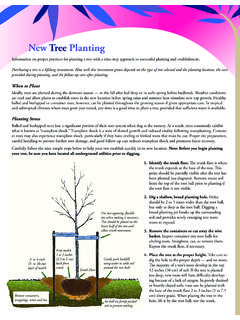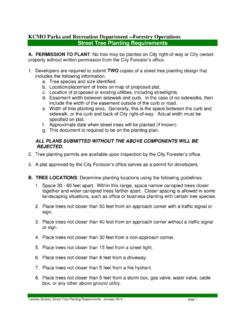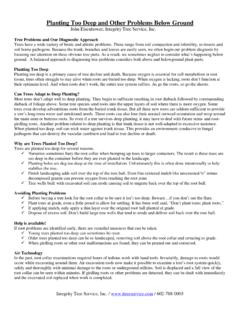Transcription of Planting trees for Living Firebreaks - Small Tree Farm in ...
1 The use of fire-retardant trees to landscape around the homestead can significantlyincrease the safety of buildings in the case of a wild fire event. Conversely having veryflammable trees near to a house makes the risk of the building catching fire muchgreater. Effective Living Firebreaks require the choice of correct tree species and goodgrounds trees can protect from fire in three ways. Firstly, by acting as a shieldagainst the immense radiant heat generated by an approaching fire, so that the houseis protected from the intense temperatures that can shatter windows and melt a large canopied tree , or a strategically placed hedge, acts to trap the burningmaterial carried in the intense fire winds.
2 This reduces the amount of flaming matter thatcan reach and ignite the building itself. Finally the stored moisture in the leaves acts asall water does; it suppresses the fire's energy. Many times even a single tree has saveda house or shed. That's why fire-retardant trees are Living vegetation can only ever be one element of a fire plan. It is not a magic cure-all. Nothing is guaranteed with wildfire but every little bit may help and a Living firebreakstands ever ready to be of some help, regardless of whether anyone is present to fightthe fire or whether everything else proceeds according to plan. At the very least it hasto be better than surrounding yourself and your property with accelerant vegetationwhich force feeds the ferocity of a trees are Retardant?
3 Page 2 How Retardants Work page 3 The Flame Test page 4 Fire Accelerant Vegetation page 5 The Hazard of Litter page 6 Planting trees for Living FirebreaksIntroductionBeing Waterwise and FirewiseThe Park as firebreakDesigning Living FirebreaksGood Managementpage 7page 8page 9page10 The best trees for fire-retardant properties arethose which have soft leaves with high moisturecontent, smooth and non-peeling barks, andlow amounts of volatile oils in their speaking this includes the majority ofdeciduous trees and some evergreens from thesub-tropics and rain Rough ScaleWhich trees are fire-retardant?
4 Kurrajong Sheoak Ferny Leaved WattlesTagasaste Cape Lilac CoprosmaMorton Bay FigLilly Pillyrainforest treesPepper tree NZ Xmas TreeCypressPinesEucalyptsBottlebrushPepp ermint Ti-treesPlease note:Scaling trees for retardanceis not an exact will vary with:Drought stressed trees with leaves that containsuboptimal moisture, or trees whose crownshave become thin because of drought inducedleaf shedding, ill health or unsuitability to the sitewill not be able to perform as effectively ashealthy behaviour is notoriously fickle and the ap-parent performance of retardants can as a resultsometimes appear confusing and the hotter the fire the better it canoverwhelm the retardant properties of a trees that would perform admirably in mildfires may not be able to contribute significantly ina severe situation - and mild and severe condi-tions can occur in different parts of the same & fire conditionsPhysical state of the treesDead wood in older trees can burn whilst thefoliage wont.
5 This is more dangerous in specieswhich have dense crowns that are leafy on theperiphery but have a hidden mass of dead twiggymaterial in the centre. In this way Tagasaste andWattles can be reasonably retardant in theiryoung fast growing stage but lose effectivenessas they mature. In the same way Cypress andTi- tree which start off dangerous enough becomepositively so as the old and dead material accu-mulates in their centres.(Accelerants)(Retardants)WorstBe stVPlease note also that there may be variation inperformance within a grouping listed on the Fruit TreesMost Deciduous TreesincludingOaks Willows PoplarsPlanes Liquidambar AshesincludingApples & Pears Stone FruitFig MulberryThe FireTriangleHeatFuelOxygenFire Retardant Plants - retardants do not provide ready fuel andwhere the combustion of their green leaves isnot a net energy producer they may be fuelreducers.
6 - retardants can act as heat shields screeningbuildings and occupants from the radiantheat projected by the fire reducing thepre-heating which facilitates ignition. - retardants can reduce or deflectfirewinds denying the extra oxygenthat can supercharge a retardants work by puttinglimitations on all of the three factorsnecessary for fire to exist:A fire retardant is a plant which actually retards the progress of the fire because theenergy required to combust the foliage is greater than the energy released from thatcombustion. The net effect is for the fire to lose energy, to slow, to "cool".Conversely accelerant vegetation contains volatile oils in its foliage and releases a lot ofenergy when it burns; increasing the ferocity of a fire enabling it to spread further between these extremes on the scale there are plants which burn without greatrelease of heat.
7 Such plants are often labelled as being retardants but this is done onthe basis that they are not great accelerants rather than because they actually , with enough energy input all plants will burn. There is nothing that is com-pletely fail-safe but it is fair to say that there must always be a difference between hav-ing retardants rather than accelerants around dwelling will also be safe to say that the bigger and hotter the fire the less effective the retard-ant will be. In an extreme event such as Victoria s Black Saturday in 2009 the effectmay be marginal, even academic, because so much heat energy is projected forwardby the firestorm.
8 In most fires however the difference could be significant, and, it mightjust make all the addition the screening foliage of retardants can trap flying emberscausing them to die out harmlessly; and retardants typically create acooler humid zone around themselves than do the FlameTestA rough idea of the fire safety ofyour gardenplants can be gained by holdingsample sprigsto a flame in safe they flare up immediately, especially at somedistance from the flame, they are a real longerthey take to ignite, and the less fiercely theyburn, the safer they should be interpreted with caution as thistest cannot replicate actual wildfire moisture in green leaves of retardants needs to be first driven out sothat they steam before they burn.
9 This sucks energy out of the fire andslows its progress as opposed to the force feeding that occurs withaccelerants. Steaming will cause browning of the leaf. It may appear thatthe tree has burned however browned leaves retained on a tree after fireindicate that steaming or scorching rather than burning occurred. Leavesthat had actually burned would have been reduced to ash. The foliage of accelerants contains adangerous mix of a high volatile oilcontent combined with low ,CallistemonDeciduousPinesAcacia, HakeaGrevillia1%2%3%4% Fire Accelerant VegetationThe ecology of eucalypts and pines has significant parallels. Both hold their seed in woody fruitshigh in the crown where it remains safe from fire.
10 The heat causes the gumnuts or cones to dry outand release their seed a few days later onto a cooled ash bed where they can germinate in a com-petition free nutrient rich environment. Without recurrent fire both types will lose dominance on asite. Both are therefore inherently fire promoting through the volatile oils in their leaves. On a hotday the air can hang so heavy with the scent of eucalyptus or pine oil that an oppressive sense ofpotential fire develops. With good reason - things will burn better when hot air is supercharged withflammable representation of volatile oil content in the foliage ofvarious tree and shrub groups.







